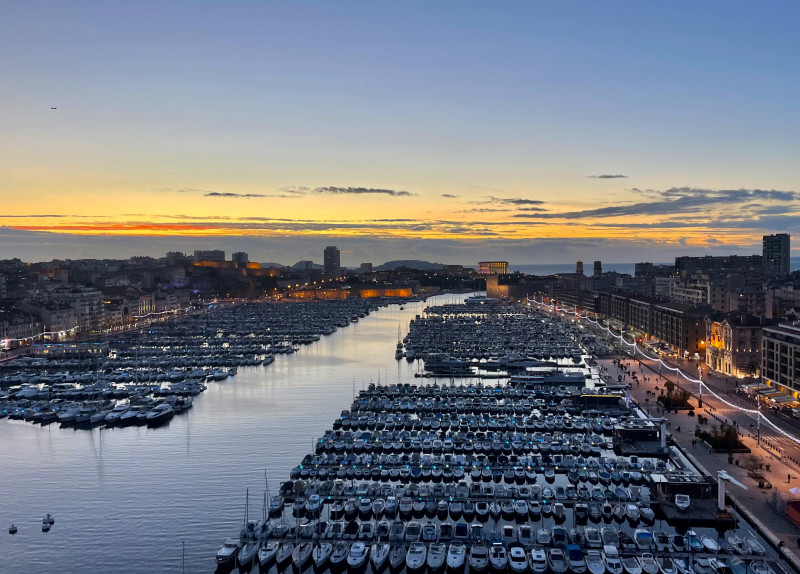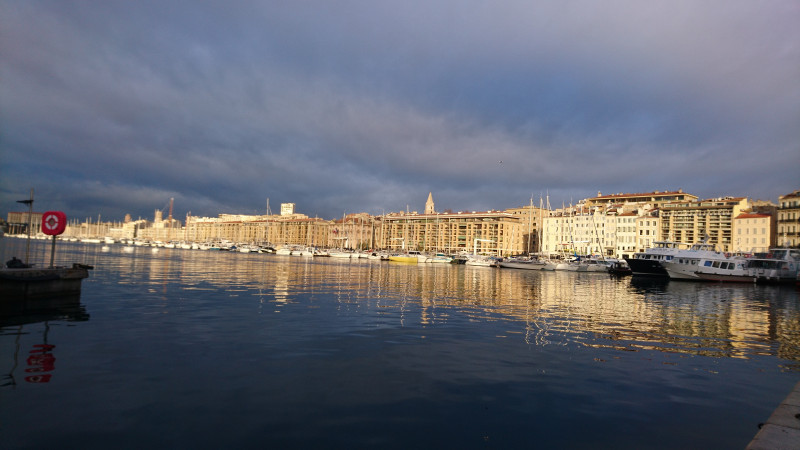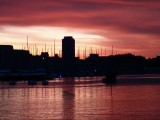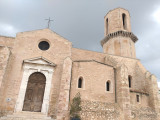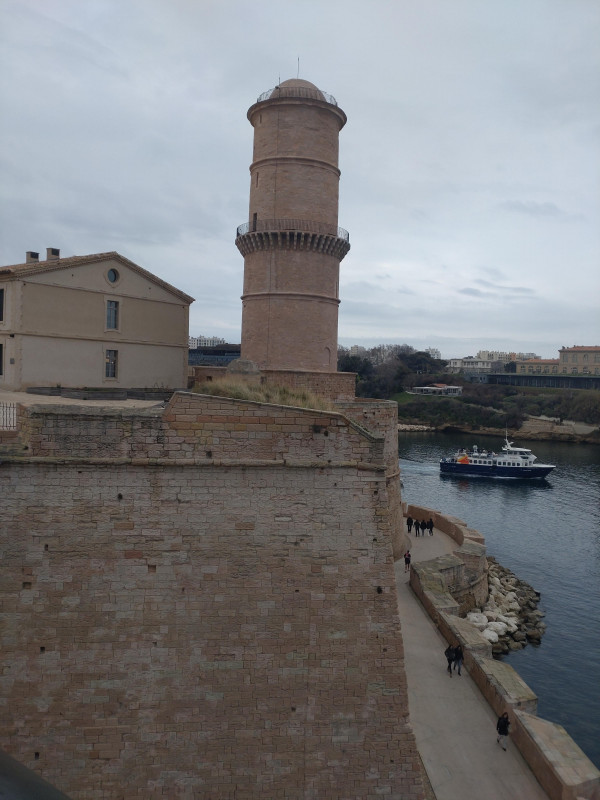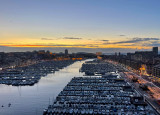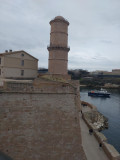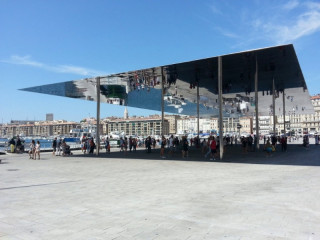The old port
Historic site and monumentPresentation
Marseille can claim to have existed for 2,600 years and therefore qualifies as France's oldest city. In 600 B.C., Greeks from Phocaea (in present-day Turkey) arrived in the Lacydon creek which was then inhabited by people belonging to the Ligurian branch of the Celts.
According to legend, Massalia (as the Greeks named Marseille) was the result of a love story, that of Protis the Greek and Gyptis, daughter of the Ligurian chieftain. She rejected princes and fortune-hunters and chose the handsome adventurer.
The choice of setting was a calculated move: the North bank where the town was built was protected by three hills (Saint-Laurent, les Moulins and les Carmes) and, other natural advantages aside, was supplied with pure spring water from the Lacydon. Moreover, the islands of Pomègues and Ratonneau constitute a formidable natural defence barrier.
Throughout Antiquity and the Middle Ages this city that the Greeks called Massalia, the Romans Massilia and that was known as Masiho in Medieval times, had its centre on the North bank. In 1666, however, Louis XIV gave instructions for the city to be extended southwards. Entrance to the port was henceforth protected by two forts: Fort Saint-Nicholas to the South and Fort Saint-Jean to the North.
One image that conjured up the Vieux-Port for many people was that of the Pont transbordeur (transporter ferry bridge), a metal structure that was commissioned from the Ateliers Arnodin in 1903 and opened two years later. It spanned the port between the Fort Saint-Nicholas and Fort Saint-Jean. One of the uprights was damaged in an explosion in 1944 and the bridge was demolished after the Second World War. The people of Marseille still have fond memories of the bridge and it has been immortalised in numerous paintings, photographs and films.
The Ferry-boat.
so cherished by the Provençal writer and film director, Marcel Pagnol, leaves from the quay in front of the City Hall to make several daily crossings of the Vieux-Port. The crossings began in June 1880, thus opening the famous passage from the City hall to the Place aux Huiles, a square located on the opposite side of the port.
Saint- Ferréol les augustins
In the 12th Century the Headquarters of the Knights Templar originally stood where the Church stands today. The Augustin monks bought the building in 1369 after the Order of the Templars was abolished and its members dispersed. Work was begun to build a Gothic church which was consecrated in 1542 but not completed until 1588. The Italian-style bell tower dates from the 18th Century. The monastery was divided up and sold during the Revolution and only the church remained. It was established as a parish in 1803 with Saint Ferréol as patron Saint in memory of the collegiate church of the same name that was destroyed in 1794 (the collegiate church originally stood where the present Prefecture stands today, in the Place Félix Baret).
The nave of the church originally comprised 5 bays and 12 side-chapels but 2 of the side-chapels were destroyed in 1804 when the city was subject to re-planning work and today the building lacks a sense of proportion and harmony. The craftsman builder Désiré Michel made the present neo-baroque façade when the Rue Impériale (now Rue de la République) was opened out into the area around the port.
The church contains a number of fine works of art such as the throne, now a National Heritage work of art, the high altar made of polychrome marble, the reliquary bust of Saint Ferréol and the paintings by the Provençal painter Michel Serre. The church also contains the ossuary of Saint Louis d'Anjou that had been stolen in 1423 when the city was pillaged it was only returned to Marseille in 1956.
The choice of setting was a calculated move: the North bank where the town was built was protected by three hills (Saint-Laurent, les Moulins and les Carmes) and, other natural advantages aside, was supplied with pure spring water from the Lacydon. Moreover, the islands of Pomègues and Ratonneau constitute a formidable natural defence barrier.
Throughout Antiquity and the Middle Ages this city that the Greeks called Massalia, the Romans Massilia and that was known as Masiho in Medieval times, had its centre on the North bank. In 1666, however, Louis XIV gave instructions for the city to be extended southwards. Entrance to the port was henceforth protected by two forts: Fort Saint-Nicholas to the South and Fort Saint-Jean to the North.
One image that conjured up the Vieux-Port for many people was that of the Pont transbordeur (transporter ferry bridge), a metal structure that was commissioned from the Ateliers Arnodin in 1903 and opened two years later. It spanned the port between the Fort Saint-Nicholas and Fort Saint-Jean. One of the uprights was damaged in an explosion in 1944 and the bridge was demolished after the Second World War. The people of Marseille still have fond memories of the bridge and it has been immortalised in numerous paintings, photographs and films.
The Ferry-boat.
so cherished by the Provençal writer and film director, Marcel Pagnol, leaves from the quay in front of the City Hall to make several daily crossings of the Vieux-Port. The crossings began in June 1880, thus opening the famous passage from the City hall to the Place aux Huiles, a square located on the opposite side of the port.
Saint- Ferréol les augustins
In the 12th Century the Headquarters of the Knights Templar originally stood where the Church stands today. The Augustin monks bought the building in 1369 after the Order of the Templars was abolished and its members dispersed. Work was begun to build a Gothic church which was consecrated in 1542 but not completed until 1588. The Italian-style bell tower dates from the 18th Century. The monastery was divided up and sold during the Revolution and only the church remained. It was established as a parish in 1803 with Saint Ferréol as patron Saint in memory of the collegiate church of the same name that was destroyed in 1794 (the collegiate church originally stood where the present Prefecture stands today, in the Place Félix Baret).
The nave of the church originally comprised 5 bays and 12 side-chapels but 2 of the side-chapels were destroyed in 1804 when the city was subject to re-planning work and today the building lacks a sense of proportion and harmony. The craftsman builder Désiré Michel made the present neo-baroque façade when the Rue Impériale (now Rue de la République) was opened out into the area around the port.
The church contains a number of fine works of art such as the throne, now a National Heritage work of art, the high altar made of polychrome marble, the reliquary bust of Saint Ferréol and the paintings by the Provençal painter Michel Serre. The church also contains the ossuary of Saint Louis d'Anjou that had been stolen in 1423 when the city was pillaged it was only returned to Marseille in 1956.
Opening period (s)All year round daily.
General information
- Park :
- Calanques National Park
Services, Tours, Activities and entertainment
- Historical patrimony :
- Historic patrimony
- Historical patrimony
Contact
The old port
13001
Marseille

Destination
Le Vieux Port
13001
Marseille
GPS coordinates
Latitude : 43.294918
Longitude : 5.373816
We also suggest...
Historic site and monument
New landmark on the Old Port designed by the British Norman Foster, the 22m by 48m Ombrière has a triple function.



